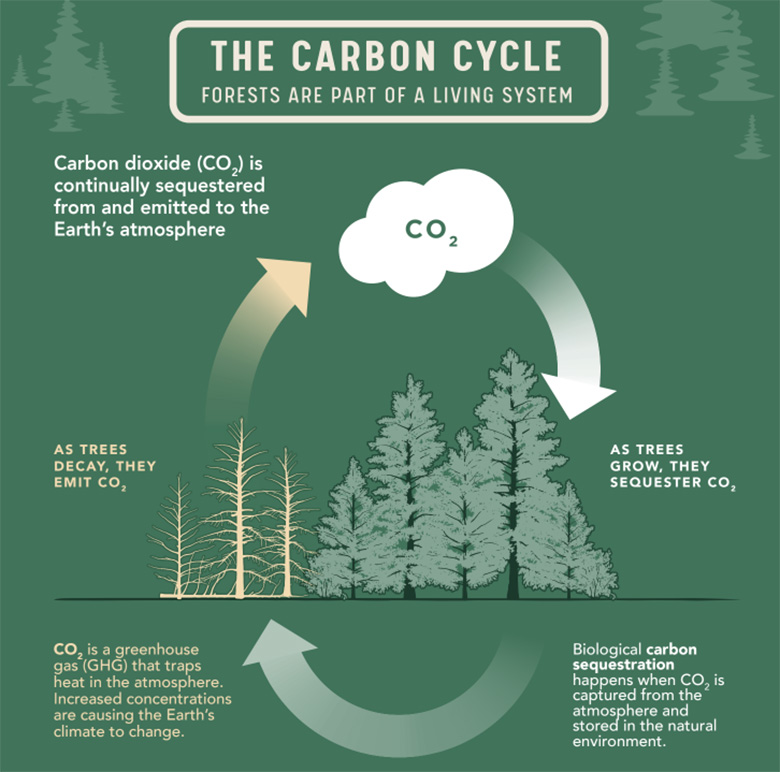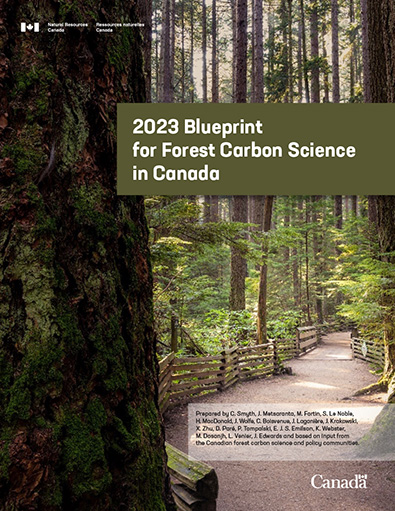Forest carbon
On this page
- The carbon cycle
- Defining carbon balance
- Forests as carbon sources and carbon sinks
- Climate change is already affecting the carbon balance of Canada’s forests
- The forest carbon blueprint
- Find out more
- Data
- Canadian Forest Service publications
The carbon cycle
The “carbon cycle” refers to the constant movement of carbon from the land and water through the atmosphere and living organisms. This cycle is fundamental to life on Earth.

Text version
"The carbon cycle: Forests are part of a living system", illustrates how carbon dioxide (CO₂) moves through a forest ecosystem. At the center of the image, there are three trees, representing different stages of growth and decay.
Carbon dioxide sequestration and emission:
The image highlights that carbon dioxide (CO₂) is continually sequestered (absorbed) and emitted (released) by the Earth's atmosphere through the forest ecosystem.
On the right side of the image, an arrow points downwards towards the trees with the text "As trees grow, they sequester CO₂." This indicates that growing trees absorb carbon dioxide from the atmosphere, which helps in reducing greenhouse gases.
Decay and emission of CO₂:
On the left side, an arrow points upwards from a decaying tree with the text "As trees decay, they emit CO₂." This shows that when trees die and decompose, they release the stored carbon dioxide back into the atmosphere.
Role of CO₂:
Below the main cycle, there is a note explaining that CO₂ is a greenhouse gas (GHG) that traps heat in the atmosphere. The increased concentrations of CO₂ are causing changes in the Earth's climate, leading to global warming.
Biological carbon sequestration:
Another note at the bottom of the image elaborates on biological carbon sequestration. It explains that when CO₂ is captured from the atmosphere and stored in natural environments like forests, it helps in mitigating climate change.
Forests are a vital part of the carbon cycle, both storing and releasing this essential element in a dynamic process of growth, decay, disturbance and renewal. At a global scale, forests help maintain Earth’s carbon balance by capturing carbon dioxide (CO2) from the atmosphere when they grow, and releasing CO2 and other greenhouse gases (GHGs) when they decay or burn.
Forests and other lands around the world moderate climate change by absorbing about one-third of the carbon emitted by human activities (burning fossil fuels, land use change). Carbon is absorbed from the atmosphere through photosynthesis. It then becomes deposited in forest biomass (trunks, branches, roots, and leaves), dead organic matter (litter and dead wood), and soils. This process of carbon absorption and deposition is known as carbon sequestration. Forest carbon is released when trees burn or when they decay after death (as a result of old age, wildland fires, insect attacks, or other disturbances).
Defining carbon balance
Earth’s carbon balance is calculated as all carbon emissions into the atmosphere minus all removals, including carbon uptake by oceans and land systems. Since the industrial use of fossil fuels began, the net carbon balance has seen increases in the atmospheric CO₂ concentration from 280 parts per million to over 400 parts per million.
Under the United Nations Framework Convention on Climate Change, Canada has had to monitor and report greenhouse gas (GHG) emissions and removals in its managed forests since 1990.
This means tracking changes resulting from forest growth, decomposition, natural disturbances (wildland fires and insects), forest management, and land-use change. Land-use change includes afforestation (creation of new forests where none exist) and deforestation (conversion of forests to non-forest land uses such as agriculture).
The net balance of these carbon exchanges determines whether a forest is a carbon source or sink. The carbon source/sink balance is as dynamic as it is complex.
Forests as carbon sources and carbon sinks
A forest is a carbon source if it releases more carbon than it absorbs.
A forest is a carbon sink if it absorbs more carbon from the atmosphere than it releases.
Prior to 1990, the best available evidence suggested that Canada's entire managed forest land, including areas impacted by both humans and natural disturbances, was a significant carbon sink, steadily adding carbon to the amount already storedFootnote 1Footnote 2.
However, since 1990, the situation has reversed. Canada’s managed forests have become carbon sources, releasing more carbon into the atmosphere than they are accumulating.
Several factors have contributed to this shift, such as:
- the substantial increase in annual total area burned by wildland fires
- unprecedented insect outbreaks
- a shift in annual harvest rates in response to economic demand
- forest management actions related to the mountain pine beetle epidemic in western Canada
Forest management actions concerning the mountain pine beetle increased in the 1990s and decreased sharply with the global economic recession in the late 2000s. This was followed by a decade of flat harvest rates.
Climate change is already affecting the carbon balance of Canada’s forests
Climate change is expected to have a profound impact on the carbon balance of Canada’s forests. The biggest short-term impacts will result from changes in disturbance regimes. Canadian Forest Service scientists predict that changes in the fire regime will increase the forest area annually burned in Canada, resulting in large emissions of carbon. More frequent and longer lasting droughts are expected to contribute to this increase.
Some aspects of climate change, such as longer growing seasons or greater concentrations of carbon dioxide in the atmosphere, may increase tree productivity. Increases will be limited by other climate-related changes, such as increased wildland fire and drought.
A warmer, wetter climate might lead to increased decomposition rates. Northern regions of Canada are expected to warm faster than more southerly areas, resulting in the thawing of permafrost. This could lead to methane being released from frozen soils, initiating decomposition of previously frozen organic carbon.
These interconnected events will likely further accelerate the feedback loop. More emissions will lead to accelerated climate change, which will drive more carbon-releasing disturbances in Canada’s forests.
The forest carbon blueprint
The Canadian Forest Service has published a renewed Blueprint for Forest Carbon Science in Canada that outlines forest carbon research priorities needed to support policy over the next decade. It serves as an update to the 2012-2020 Forest Carbon Science Blueprint.
Our knowledge of forest carbon science has advanced significantly over the past few decades, greatly influencing forest carbon policy. However, there are still a lot of unknowns, and national and international policies need to be supported by the best available science. The Blueprint responds to these needs.
The Blueprint’s overarching forest carbon science-policy themes were developed in collaboration with the forest carbon science and policy communities across Canada. These themes are:
- the impact of human actions on forest carbon
- impacts of environmental factors, climate change and natural disturbances on forest carbon
- climate change mitigation measures in the forest sector
- Indigenous perspectives and traditional knowledge
- connecting carbon to other values
The research goals outlined in the Blueprint under these themes will aid in filling regional, national and international data gaps. They will also support Canada’s objectives and obligations for climate change mitigation and adaptation, sustainable forest management, and GHG reporting requirements.
The knowledge generated will benefit governments, forest industry, environmental organizations, Indigenous organizations. It will also help others in Canada who are interested in how forests can be managed and how forest biomass can be used to maintain carbon storage, increase carbon removals from the atmosphere, and reduce GHG emissions.
Find out more
Data
Canadian Forest Service publications
- Improving Canada's forest carbon estimates (2023)
- Future fire risk and the greenhouse gas mitigation potential of forest rehabilitation in British Columbia, Canada (2023)
- Forest Carbon 101: How Canada calculates forest carbon (2023)
- 2023 Blueprint for Forest Carbon Science in Canada (2023)
- How does Canada report greenhouse gas emissions from wildfire? (2024)
- Is Canada’s forest a carbon sink or source? (2024)
Page details
- Date modified:
